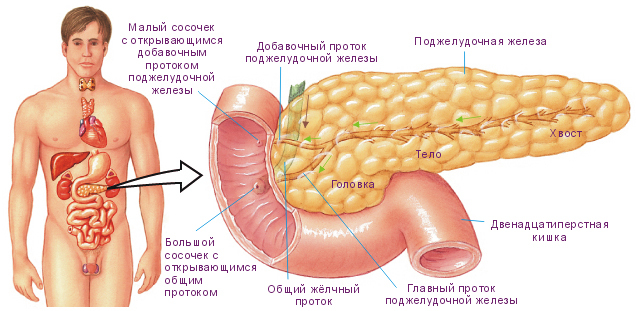What are the functions of the hormones of the pancreas?
Pancreatic hormones are biologically active substances that help digest fatty foods.
In this article, we will look at what hormones the pancreas produces.
Assignment of the pancreas
Contents:
- Pancreatic function
- Insulin, amylin and C-peptide
- Glucagon, pancreatic polypeptide, gastrin
To better understand what hormones secrete the pancreas and their functions, let's consider its structure in more detail.
The pancreas contains the endocrine, exocrine parts, the role of each in its own way is special.
Digestive juice produces the exocrine part of the pancreas. Gastric juice contains a large number of molecules that help digest meat and other heavy foods.
The second part of the gland, endocrine, deals with the development of the active substances necessary for man, it monitors the metabolism of carbohydrates in the body.
It is not difficult to notice by name, the endocrine gland is named so because it consists of several endocrine cells: there are many of them, they carry out the function of producing hormones.
There are several main types of endocrine cells:
- alpha cells.20% of all pancreatic cells are made up of them. Their main function is the production of glucagon;
- beta cells. With age, the beta cells gradually disappear, their function is to produce insulin, amylin. Quantity - 80%;
- delta cells. Their number reaches only 10%, their function is the production of somatostatin.
- ji-cells - secrete gastrin;
- PP cells. Probably, they are the least. Their function is the production of a pancreatic polypeptide.
Cells of the endocrine gland are evenly distributed throughout the entire body area, with a total of 3%.

Hormones secreted by the pancreas:
- insulin;
- C-peptide;
- glucagon;
- pancreatic polypeptide;
- gastrin;
- amylin.
Insulin, amylin and C-peptide
There are several different active substances released by the gland, each of which has its own function, structure, structure.
Insulin( from the Latin insula - island) - the most important anabolic, protein hormone, is formed from proinsulin.
Functions: transport of amino acids and ions, controls metabolic processes, changes cells. This substance produces beta cells.
Its tasks are to stop the digestible sugar in our body and reduce the formation of glucose in the liver. In short, the main function is the lowering of blood sugar.
When a person is engaged in sports, his blood is filled with insulin to compensate for glucose, also the hormone makes "stores" of sugar in the body, helps to synthesize it into energy.
Failure of this process can lead to an increase in glucose, then to diabetes. Until 1921, diabetes could not be treated, the patient was likely to die.
Now, if there is a suspicion of an overabundance of sugar, people take tests. The organism of patients of the first group of diabetes insulin can not produce. Lack of mobility, overeating, eating fatty foods can cause diabetes of the second type.
Video:
Insulin saved the lives of many people with diabetes. Prior to its opening, people with diabetes mellitus were dying, doctors kept them on hunger diets.
These patients could not be operated, some died from other diseases requiring surgery.
On average, an adult has 5 grams of this hormone in the body. Insulin is a necessary hormone for the body, is present in some protozoa.
Its structure is almost the same for all creatures, a similar animal biologically active substance can be used for injections to humans.
For example, insulin bulls differ only three amino acids from a human, and a pork - to one amino acid.
Dolphins, horses, cats, dogs and other animals are also ill with diabetes. The reason for this is overfeeding by the owners.
C-peptide is used to detect type 1 and type 2 diabetes, various liver diseases.
This is a separated molecule of pro-insulin that has appeared in the blood. It is almost completely equalized with insulin in the analysis.
An increase in the C-peptide occurs when the tumor forms( insulinoma).C-peptide is used to diagnose diabetes mellitus, adjust treatment.
The amount of pancreatic hormones depends on:
- of sugar in food;
- glucose oxidation rate;
- the amount of other hormones performing a similar function.
Glucagon secretion increases with decreasing sugar, insulin release increases with diabetes mellitus.
If blood sugar is lowered, then glucagon release increases, if diabetes is present, then insulin secretion increases.
Amilin was discovered recently, in 1970.In 1990, it began to be investigated. It turned out that its function is to control blood sugar by reducing appetite.
After that, additional enzymes that reduce appetite and glucose enter the bloodstream. The consequence of the activity of amylin is weight loss. It is represented in the stomach, trachea, nervous system.
Glucagon, pancreatic polypeptide, gastrin
Glucagon is a polypeptide. In addition to the pancreas, it is also produced by the intestinal mucosa. Despite the same names, glucagon intestine and glucagon of the pancreas are different things.
Unlike insulin, glucagon increases sugar. This may seem strange, since excess glucose is harmful to the body, but there are several more hormones that perform the function of insulin.
Isolation of glucagon occurs when the human body receives amino acids, fats, sugar, proteins.
Glucose actively inhibits the production of glucagon, its action is leveled by other hormones of the digestive tract. The structure of human glucagon is similar to the glucagon of mammals.
Detection of glucagon occurred two years after insulin( 1923).At first no one was interested in them.
More detailed discovery of the functions of glucagon occurred in a few years. The frequency of its use in medicinal purposes is much lower than insulin.
Video:
Pancreatic polypeptide is one of the most "young" hormones, and it is produced only by the endocrine gland cells, and nowhere else.
It stands out when a person consumes meat, cottage cheese, other similar food. It was recently discovered that it saves digestive enzymes.
Gastrin affects the digestion of food. Violation of its secretion can cause various gastrointestinal diseases.
There are three types of gastrin:
- large( consists of 34 amino acids);
- is small( 17 amino acids are included);
- microgastrin( 14 amino acids).
Gastrin is produced in the pancreas, but less than in the stomach. Its function is to control the release of other hormones involved in digestion.
People with suspected stomach ulcers or Zollinger-Ellison syndrome are given an analysis for gastrin. If its high content is observed, then the probability of developing or having a stomach ulcer is high.
After reading this article, you learned about what hormones of the pancreas happen and what functions they perform in the human body. Be healthy!


